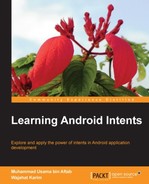Book Description
If you already know at least the basics of Android, this is an opportunity to enhance your knowledge and acquire a deep understanding of Android Intents, allowing you to develop apps faster and more effectively.
In Detail
Android is an emerging technology with loads of apps in the Google Play Market. Till date, it is the biggest marvel in Smartphone technology, propelling a larger number of developers into Android application development. Intent is an essential part of any Android Application and no Android application is complete without using them. Features such as listening broadcasts, sending messages, sharing via social networks, notifications, hardware components including camera, sensors, Wi-Fi, and more, can be used in your applications by using Intents.
This practical guide focuses on using intents to make the best use of various features of Android platform. It is ideal for those developers who want to understand the backbone and the domain of Android Intents, its power, and the need for it inside an Android application. Practical, in-depth examples are used throughout the book, to help you understand the key concepts.
The book starts with introducing the very basic concepts of Android, and its various facts and figures such as different Android versions, their release dates, evolution of Android phones and so on. While covering the basic technical concepts, it proceeds from the easiest route of introducing Android Intents towards the more practical view of Android Intents in terms of components and features.
You will learn how to use different components and features such as transfer data between activities, invoke various features and components of Android, execute different in-built and custom-made services, use hardware and software components of Android device, and start Pending Intents & notifications. You will gain better theoretical knowledge of what is running behind the concepts of Android Intents, and practical knowledge of the mobile-efficient ways to perform a certain task using Android Intents.
Towards the end, you will have a clear vision and a practical grip on Android intents and its features. Learning Android Intents is a proper guide to give you the best knowledge of Intents.
What You Will Learn
- Understand Android Intents and their importance in Android apps
- Get to grips with the different types of Intents and their implementation
- Discover data transfer methods in Android Intents along with their optimization and performance comparisons
- Explore the implementation of Intents while invoking Android Features in an application.
- Use Intent Filters and their sub-domains in order to perform various actions and sorting categories in Android Intents
- Catch different events while working with Broadcast Receiver and perform various actions
- Implement pending Intents and Intent Service, sending text to the Notification Panel, and much more
Downloading the example code for this book. You can download the example code files for all Packt books you have purchased from your account at http://www.PacktPub.com. If you purchased this book elsewhere, you can visit http://www.PacktPub.com/support and register to have the files e-mailed directly to you.
Table of Contents
- Learning Android Intents
- Table of Contents
- Learning Android Intents
- Credits
- About the Authors
- About the Reviewers
- www.PacktPub.com
- Preface
- 1. Understanding Android
- 2. Introduction to Android Intents
- Role of intents in an Android Application
- Role of intents in Android Activities
- Role of intents in data transfer between activities
- Role of intents in Wi-Fi and Bluetooth transfer
- Role of intents in Android Camera
- Role of intents in GPS Sensor
- Role of intents in sending SMS/MMS
- Role of intents in Mobile Calls
- Role of intents in e-mail and social network posts
- Role of intents in Android Services
- Role of intent in Broadcast Receiver
- Role of intent in time zones
- Role of intent in Status Bar
- Intent – a technical overview
- Implementation of Android Intents for Activity Navigation
- Structure of an intent
- Summary
- Role of intents in an Android Application
- 3. Intent and Its Categorization
- Explicit intents
- Implicit intents
- Intents and Android late binding
- Summary
- 4. Intents for Mobile Components
- Common mobile components
- Components and intents
- Summary
- 5. Data Transfer Using Intents
- Finding the need to transfer data
- Data transfer between activities – an INTENTed way
- Data transfer in explicit intents
- Methods of data transfer between activities
- Data transfer using putExtras()
- Data transfer using Parcelable
- Data transfer using Serializable
- What is Serializable?
- An example of Serializable
- Implementation of Serializable
- Passing Serializable – a tutorial
- Walking through the Serializable code
- 6. Accessing Android Features Using Intents
- 7. Intent Filters
- 8. Broadcasting Intents
- 9. Intent Service and Pending Intents
- Index
